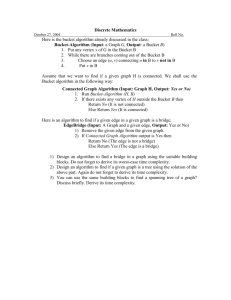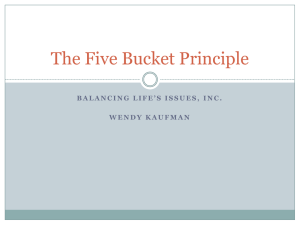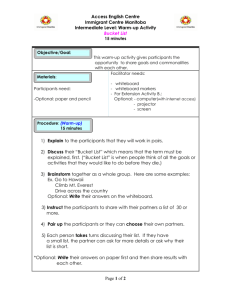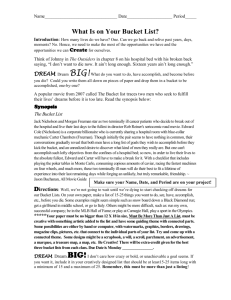water flow measurement – bucket, floating and current flowmeter
advertisement
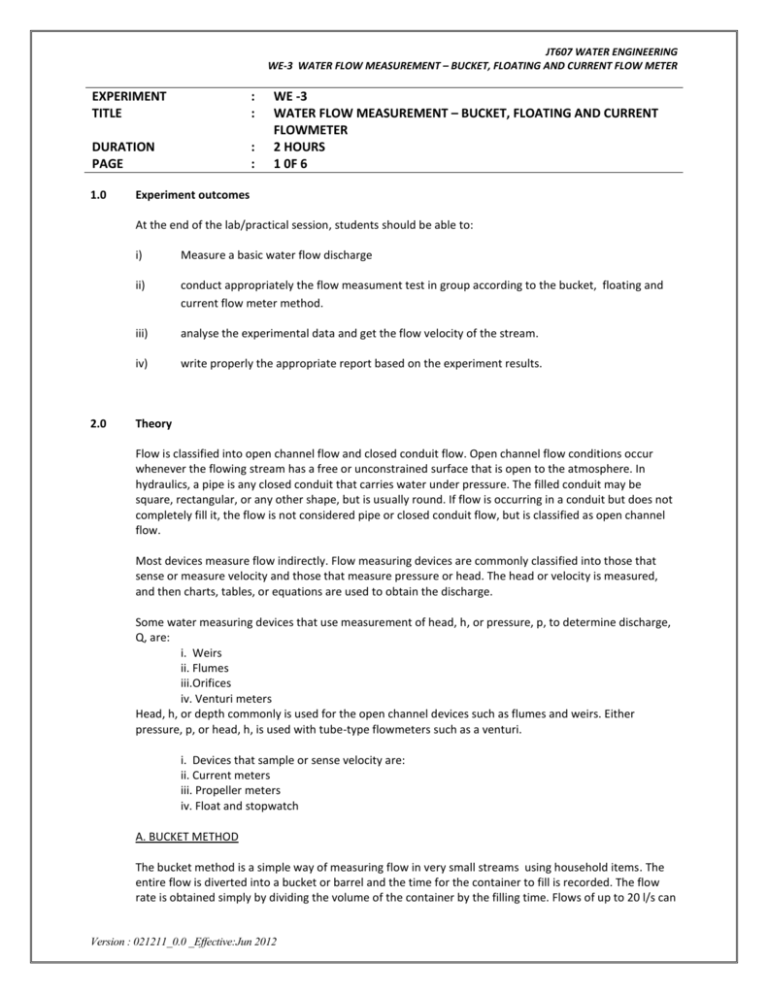
JT607 WATER ENGINEERING WE-3 WATER FLOW MEASUREMENT – BUCKET, FLOATING AND CURRENT FLOW METER EXPERIMENT TITLE : : DURATION PAGE : : 1.0 WE -3 WATER FLOW MEASUREMENT – BUCKET, FLOATING AND CURRENT FLOWMETER 2 HOURS 1 0F 6 Experiment outcomes At the end of the lab/practical session, students should be able to: 2.0 i) Measure a basic water flow discharge ii) conduct appropriately the flow measument test in group according to the bucket, floating and current flow meter method. iii) analyse the experimental data and get the flow velocity of the stream. iv) write properly the appropriate report based on the experiment results. Theory Flow is classified into open channel flow and closed conduit flow. Open channel flow conditions occur whenever the flowing stream has a free or unconstrained surface that is open to the atmosphere. In hydraulics, a pipe is any closed conduit that carries water under pressure. The filled conduit may be square, rectangular, or any other shape, but is usually round. If flow is occurring in a conduit but does not completely fill it, the flow is not considered pipe or closed conduit flow, but is classified as open channel flow. Most devices measure flow indirectly. Flow measuring devices are commonly classified into those that sense or measure velocity and those that measure pressure or head. The head or velocity is measured, and then charts, tables, or equations are used to obtain the discharge. Some water measuring devices that use measurement of head, h, or pressure, p, to determine discharge, Q, are: i. Weirs ii. Flumes iii.Orifices iv. Venturi meters Head, h, or depth commonly is used for the open channel devices such as flumes and weirs. Either pressure, p, or head, h, is used with tube-type flowmeters such as a venturi. i. Devices that sample or sense velocity are: ii. Current meters iii. Propeller meters iv. Float and stopwatch A. BUCKET METHOD The bucket method is a simple way of measuring flow in very small streams using household items. The entire flow is diverted into a bucket or barrel and the time for the container to fill is recorded. The flow rate is obtained simply by dividing the volume of the container by the filling time. Flows of up to 20 l/s can Version : 021211_0.0 _Effective:Jun 2012 JT607 WATER ENGINEERING WE-3 WATER FLOW MEASUREMENT – BUCKET, FLOATING AND CURRENT FLOW METER EXPERIMENT TITLE : : DURATION PAGE : : WE -3 WATER FLOW MEASUREMENT – BUCKET, FLOATING AND CURRENT FLOWMETER 2 HOURS 2 0F 6 be measured using a 200-litre oil barrel. It requires a stopwatch, a large bucket, and preferably two to three people. B. FLOAT METHOD The principle of all velocity-area methods is that flow Q equals the mean velocity Vmeans times crosssectional A: Q=A × Vmean (m3/s) One way of using this principle is for the cross-sectional profile of a stream bed to be charted and an average cross-section established for a known length of stream. A series of floats, perhaps convenient pieces of wood, are then timed over a measured length of stream. Results are averaged and a flow velocity is obtained. This velocity must then be reduced by a correction factor which estimates the mean velocity as opposed to the surface velocity. By multiplying averaged and corrected flow velocity, the volume flow rate can be estimated. Version : 021211_0.0 _Effective:Jun 2012 JT607 WATER ENGINEERING WE-3 WATER FLOW MEASUREMENT – BUCKET, FLOATING AND CURRENT FLOW METER EXPERIMENT TITLE : : DURATION PAGE : : WE -3 WATER FLOW MEASUREMENT – BUCKET, FLOATING AND CURRENT FLOWMETER 2 HOURS 3 0F 6 C. CURRENT METERS These consist of a shaft with a propeller or revolving cups connected to the end. The propeller is free to rotate and the speed of rotation is related to the stream velocity. A simple mechanical counter records the number of revolutions of a propeller placed at a desired depth. By averaging readings taken evenly throughout the cross section, an average speed can be obtained which is more accurate than with the float method. 3.0 Apparatus/Equipments A. BUCKET METHOD B. FLOAT METHOD C. CURRENT METERS 1. Bucket/pail – 5 liter capacity 1. Float 1. current flowmeter set 2. Measuring tape 2. Data given below 2. Water source – from tap 3. Stop watch 3. Stop watch 4.0 Safety Precautions 1. Act safely at all times, using appropriate precautions when necessary. 2. Only work in the lab with proper supervision from the instructor. 3. Obey all instructions from the laboratory instructor. 4. Take care all equipment used. Version : 021211_0.0 _Effective:Jun 2012 JT607 WATER ENGINEERING WE-3 WATER FLOW MEASUREMENT – BUCKET, FLOATING AND CURRENT FLOW METER EXPERIMENT TITLE : : DURATION PAGE : : 5.0 WE -3 WATER FLOW MEASUREMENT – BUCKET, FLOATING AND CURRENT FLOWMETER 2 HOURS 4 0F 6 Procedures A. BUCKET METHOD To measure the flow rate using the bucket method: 1. Measure the volume of the bucket or container. 2. Find a location along the stream that has a waterfall. If none can be found, a waterfall can be constructed using a water hose. 3. With a stopwatch, time how long it takes the waterfall to fill the bucket with water. Start the stopwatch simultaneously with the start of the bucket being filled and stop the stopwatch when the bucket fills. The bucket should not be filled by holding it below the surface of the stream because it is not the true flow rate. 4. Record the time it takes to fill the bucket. 5. Repeat steps two and three about six or seven times and take the average. It is a good idea to do a few trial runs before recording any data so that one can get a feel for the timing and measurements required. 6. Only eliminate data if major problems arise such as debris from the stream interfering with the flow. 7. The flow rate is the volume of the bucket divided by the average time it took to fill the bucket. B. FLOAT METHOD 1. 2. Measure off at least 50 feet along the bank of a straight section of stream. If possible, string a rope across each end of the 50-foot length. Estimate the cross-sectional area of the stream at one of these ends by using the total stream width and the average depth. (Calculate the average depth from depths measured at 1- to 2-foot intervals.) Total width (ft) x Average depth (ft) = area (ft2) 3. 4. 5. Release the float at the upstream site. Using a stopwatch, record the time it takes to reach the downstream tape. (If the float moves too fast for an accurate measurement, measure off 75 or 100 feet instead of 50). Repeat the measurement two more times for a total of three measurements. Calculate the velocity as distance traveled divided by the average amount of time it took the float to travel the distance. If the distance roped off is 50 feet and the orange took an average of 100 seconds to get there, the velocity is 0.5 ft/sec. Correct for the surface versus mid-depth velocity by multiplying the surface velocity by 0.85. 0.5 x 0.85 = 0.43 ft/sec C. CURRENT METERS 1. 2. Observe the current flowmeter component. Analyse data from figure G and fullfill the table H Version : 021211_0.0 _Effective:Jun 2012 JT607 WATER ENGINEERING WE-3 WATER FLOW MEASUREMENT – BUCKET, FLOATING AND CURRENT FLOW METER EXPERIMENT TITLE : : DURATION PAGE : : 6.0 WE -3 WATER FLOW MEASUREMENT – BUCKET, FLOATING AND CURRENT FLOWMETER 2 HOURS 5 0F 6 Result/Data A. BUCKET METHOD B. FLOAT METHOD Bucket Method Data for Flow Trial Number Time (seconds) Float Method Data for Flow Bucket Volume (L) Trial Number 1 1 2 2 3 3 4 4 5 5 C. CURRENT METERS Figure G Version : 021211_0.0 _Effective:Jun 2012 Time (seconds) Bucket Volume (L) JT607 WATER ENGINEERING WE-3 WATER FLOW MEASUREMENT – BUCKET, FLOATING AND CURRENT FLOW METER EXPERIMENT TITLE : : DURATION PAGE : : WE -3 WATER FLOW MEASUREMENT – BUCKET, FLOATING AND CURRENT FLOWMETER 2 HOURS 6 0F 6 Current flowmeter Method Data for Flow and Discharge 1 2 Section 3 4 Flow velocity (m/s) 0.2D 0.8D 5 6 7 8 Depth (m) Width (m) Area (m2) Flow (m3/s) mean 1 2 3 4 5 6 7 Total D is the depth of the stream at the mid-point of each section Table H 7.0 Data Analyse / observation / Discussion 8.0 Conclusion and Recommendation Your conclusion should be related to your practical and theoretical understanding on the related topic. 9.0 References Version : 021211_0.0 _Effective:Jun 2012


